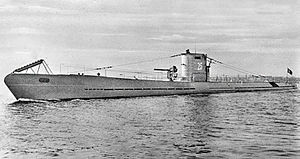German submarine U-26 (1936)

|
|
| History | |
|---|---|
|
|
|
| Name: | U-26 |
| Ordered: | 17 December 1934 |
| Builder: | DeSchiMAG AG Weser, Bremen |
| Yard number: | 904 |
| Laid down: | 1 August 1935 |
| Launched: | 14 March 1936 |
| Commissioned: | 6 May 1936 |
| Fate: | Scuttled 1 July 1940, southwest of Ireland. 48 survivors |
| General characteristics | |
| Displacement: |
|
| Length: | 72.39 m (237 ft 6 in) |
| Beam: | 6.21 m (20 ft 4 in) |
| Draught: | 4.30 m (14 ft 1 in) |
| Propulsion: |
|
| Range: |
|
| Test depth: | 200 m (660 ft) |
| Complement: | 4 officers, 39 enlisted |
| Armament: |
|
| Service record | |
| Part of: | |
| Identification codes: | M 07 314 |
| Commanders: | |
| Operations: | Six patrols |
| Victories: | |
German submarine U-26 was one of the two Type IA ocean-going U-boats produced by Nazi Germany's Kriegsmarine. Constructed in Bremen, U-26 was commissioned in May 1936. She experienced a short, but successful combat career, sinking eleven ships.
Until 1940, U-26 was primarily used as training vessel and for propaganda purposes by the German government. During her trials it was found that the Type IA submarine was difficult to handle due to her poor stability and slow dive rate.
In early 1940, the boat was called into combat duty due to the shortage of available submarines. U-26 participated in six war patrols, sinking eleven ships and badly damaging one other. On her first patrol laying mines, U-26 sank three merchant ships and damaged one British warship. On her second war patrol it became the first U-boat during World War II to enter the Mediterranean Sea. U-26 participated in three other successful patrols, sinking four additional merchant ships.
Laid down by DeSchiMAG AG Weser in Bremen as yard number 904 on 1 August 1935, U-26 was launched on 14 March 1936. She was commissioned on 6 May with Kapitänleutnant Werner Hartmann in command.
U-26 carried out six patrols between August 1939 and July 1940, during which she sank or damaged 12 ships.
The boat was scuttled southwest of Ireland after being badly damaged by depth charges dropped by the British Flower-class corvette HMS Gladiolus and an Australian Sunderland flying boat of No. 10 Squadron RAAF. The crew (48 men), all survived.
...
Wikipedia
